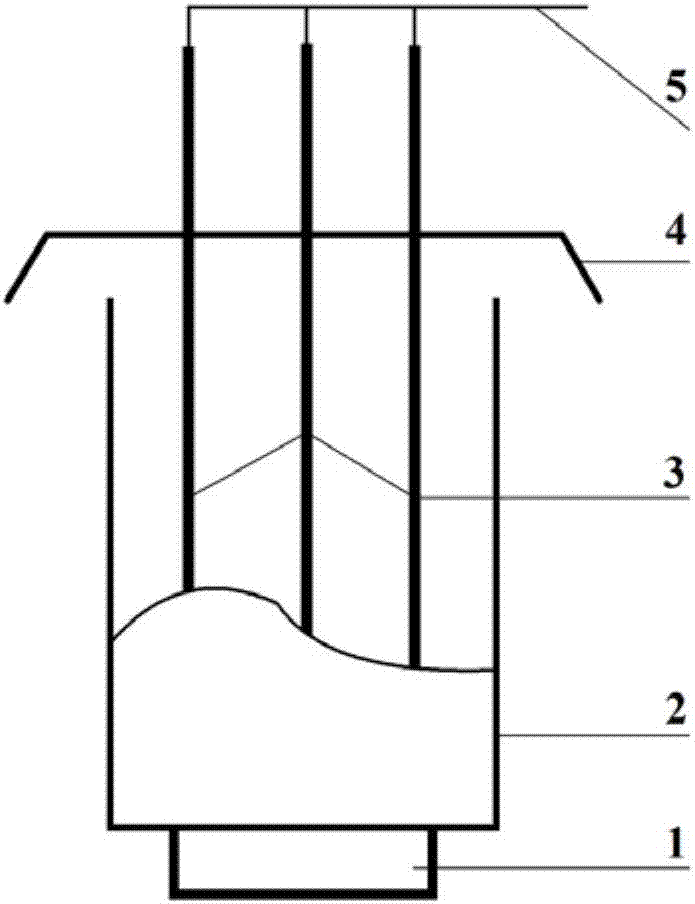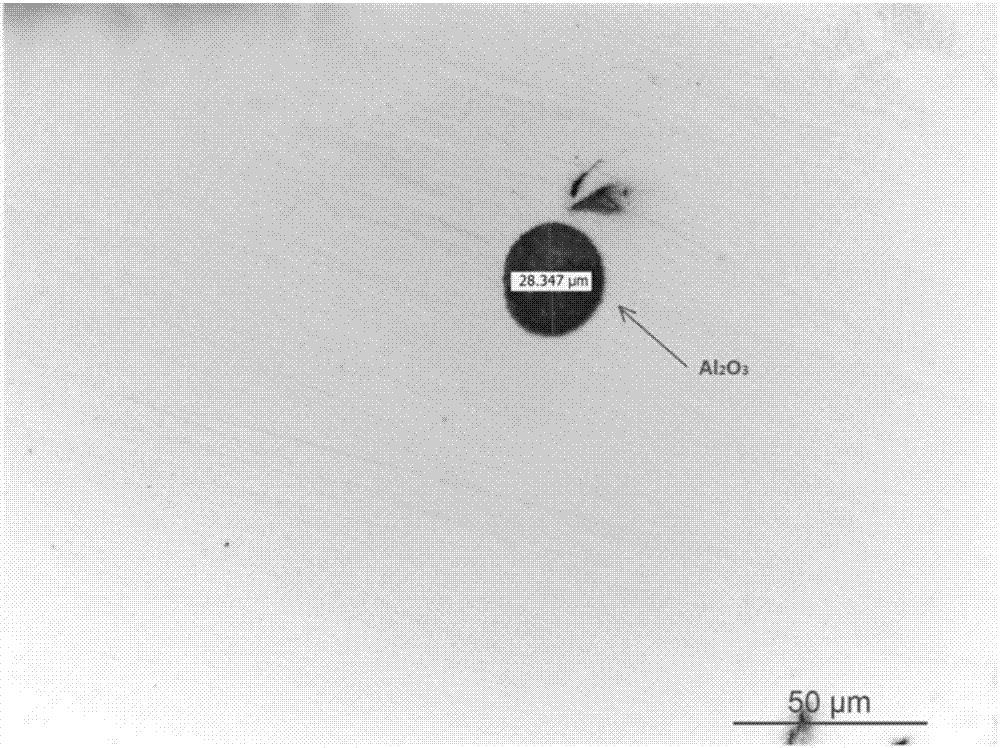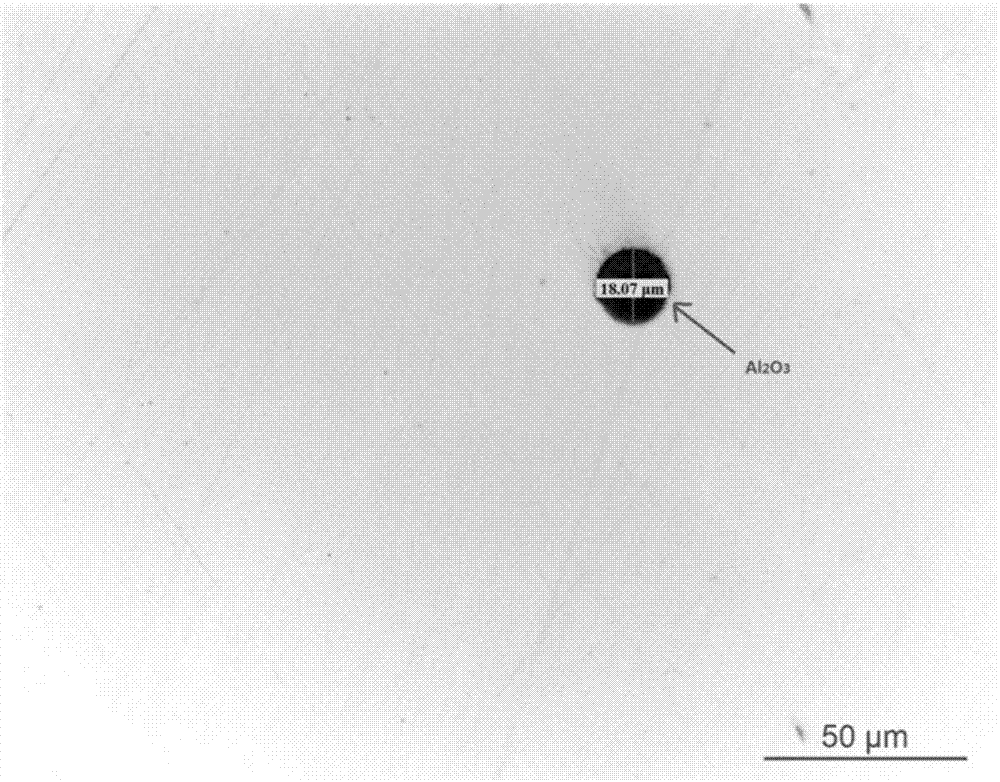Method for smelting vanadium-based alloy
An alloy, vanadium-based technology, applied in the field of smelting vanadium-based alloys, can solve problems such as the melting point temperature difference between vanadium and aluminum elements, the volatilization loss of aluminum elements, and the increase in secondary costs, so as to reduce element or phase segregation, and promote crystal grains. The effect of refinement, reduction of shrinkage and porosity
- Summary
- Abstract
- Description
- Claims
- Application Information
AI Technical Summary
Problems solved by technology
Method used
Image
Examples
Embodiment 1
[0061] A method for preparing a 55 vanadium aluminum alloy block by electric thermite-ultrasonic refining is carried out according to the following process steps:
[0062] (1) In terms of molar percentage, 11.87% V 2 o 5 , 84.63% Al and 3.50% CaF 2 Put the mixture into the reaction tank, ignite and heat with a carbon electrode, the ignition temperature is 1000°C, so that the aluminothermic reduction reaction proceeds, the reaction time is 0.5h, and the reaction temperature reaches 1800-1900°C;
[0063] (2) After the reduction reaction described in step (1) ends, the reaction tank is static for 3 minutes, and a transducer is used to carry out an ultrasonic refining treatment on the bottom of the reaction tank, the time is 5 minutes, and the power is 1000W; then the reaction tank is static for 5 minutes, and the sedimentation process is carried out ;
[0064] (3) After the sedimentation treatment described in step (2), carry out the secondary ultrasonic refining treatment, th...
Embodiment 2
[0070] A method for refining and preparing 65 vanadium aluminum alloy blocks is carried out according to the following process steps:
[0071] (1) In terms of molar percentage, 12.38% V 2 o 5 , 83.77% Al and 3.85% CaF 2 Put the mixture into the reaction tank, ignite and heat with a carbon electrode, the ignition temperature is 1200°C, so that the aluminothermic reduction reaction proceeds, the reaction time is 0.8h, and the reaction temperature reaches 1900-1950°C;
[0072] (2) After the reduction reaction described in step (1) ends, the reaction tank is static for 5 minutes, and a transducer is used to carry out an ultrasonic refining treatment on the bottom of the reaction tank, the time is 8 minutes, and the power is 900W; then the reaction tank is static for 5 minutes, and the sedimentation process is carried out ;
[0073] (3) After the sedimentation treatment described in step (2), carry out the secondary ultrasonic refining treatment, the time is 12min, and the power...
Embodiment 3
[0079] A kind of refining preparation FeV 80 The method for the intermediate alloy block is carried out according to the following process steps:
[0080] (1) In terms of molar percentage, 4.91% V 2 o 5 , 20.27% V 2 o 3 , 63.58% Al, 7.66% Fe and 3.68% CaCO 3 Put the mixture into the reaction tank, ignite and heat with a carbon electrode, the ignition temperature is 1300°C, so that the aluminothermic reduction reaction proceeds, the reaction time is 4h, and the reaction temperature reaches 1900-1950°C;
[0081](2) After the reduction reaction described in step (1) ends, the reaction tank is static for 5 minutes, and a transducer is used to carry out an ultrasonic refining treatment on the bottom of the reaction tank, the time is 10 minutes, and the power is 800W; then the reaction tank is static for 5 minutes, and the sedimentation process is carried out ;
[0082] (3) After the sedimentation treatment described in step (2), carry out the secondary ultrasonic refining tre...
PUM
| Property | Measurement | Unit |
|---|---|---|
| particle diameter | aaaaa | aaaaa |
| particle diameter | aaaaa | aaaaa |
| particle diameter | aaaaa | aaaaa |
Abstract
Description
Claims
Application Information
 Login to View More
Login to View More - R&D
- Intellectual Property
- Life Sciences
- Materials
- Tech Scout
- Unparalleled Data Quality
- Higher Quality Content
- 60% Fewer Hallucinations
Browse by: Latest US Patents, China's latest patents, Technical Efficacy Thesaurus, Application Domain, Technology Topic, Popular Technical Reports.
© 2025 PatSnap. All rights reserved.Legal|Privacy policy|Modern Slavery Act Transparency Statement|Sitemap|About US| Contact US: help@patsnap.com



